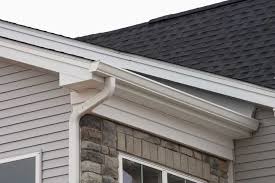- By Bella Blog
- Gutters
- 0 Comment
Discover the key indicators that signal it’s time to replace your gutters to protect your home.
Visible cracks or splits in the gutters
If you notice visible cracks or splits in your gutters, it may be a sign that it’s time for new ones. Cracks and splits can occur due to age, weather damage, or improper installation. These openings can cause water to leak and flow down the side of your house instead of being directed away from it. This can lead to water damage to your foundation, walls, and landscaping. If you see any cracks or splits in your gutters, it’s best to replace them to ensure proper functionality.
Another indication of needing new gutters is if you see rust or corrosion on your current gutters. Rust can weaken the structure of the gutters and make them more prone to leaks and damage. Additionally, rust can spread to other parts of your gutter system and cause further deterioration. If you notice rust or corrosion, it’s a good idea to have your gutters replaced.
Sagging or pulling away from the house
Gutters that are sagging or pulling away from the house are another sign that they need to be replaced. This can happen over time due to the weight of debris, such as leaves and twigs, accumulating in the gutters. When the gutters become overloaded, they can start to sag and pull away from the house. This not only affects the appearance of your home but also compromises the effectiveness of the gutters. When gutters are sagging, they may not be able to properly direct water away from your home, leading to potential water damage.
Another reason for gutters to sag or pull away from the house is improper installation. If the gutters were not securely attached to begin with, they are more likely to sag over time. In this case, replacing the gutters with a properly installed system is necessary to ensure they function as intended.
Frequent clogs or water overflow
Experiencing frequent clogs or water overflow in your gutters is a clear sign that they need to be replaced. Clogs can occur when debris, such as leaves, twigs, or dirt, accumulate in the gutters and prevent water from flowing freely. This can lead to water overflowing from the gutters instead of being directed away from your home. Not only can this cause damage to your siding and landscaping, but it can also result in water seeping into your foundation, leading to costly repairs.
If you find yourself constantly dealing with clogged gutters or water overflowing from them, it’s time to invest in new gutters that are designed to prevent clogs and efficiently channel water away from your home.
Pools of water around the foundation
One of the most serious signs that you need new gutters is the presence of pools of water around the foundation of your home. When gutters are not functioning properly or are in need of repair, water can overflow and accumulate near the foundation. This can lead to a variety of issues, including foundation damage, basement flooding, and mold growth. It’s crucial to address this problem promptly by replacing your gutters to prevent further damage to your home’s foundation.
In addition to pools of water, you may also notice erosion or water stains around the foundation. These are further indications of gutter problems that should not be ignored.
Peeling paint or water damage on the exterior of your home
If you notice peeling paint or water damage on the exterior of your home, it could be a result of faulty or damaged gutters. When gutters are not effectively channeling water away from your home, it can lead to water seeping into the walls and causing paint to peel. This can also result in water damage to the exterior siding of your home, which can be expensive to repair.
To prevent further damage and maintain the appearance of your home, it’s important to replace your gutters if you notice any signs of peeling paint or water damage on the exterior.
Bella Blog
Welcome to Bella Construction & Developement Inc., where excellence meets affordability in the realm of construction services.

